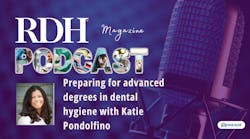The bachelor’s degree advantage: Elevating job satisfaction in your dental hygiene career
When it comes to dental hygiene, new graduates overwhelmingly choose to work in clinical practice, and most hold an associate's degree. Dental hygiene is known for having flexible hours and an excellent work-life balance. However, the job is physically demanding and often leaves dental hygienists looking for alternative jobs or thinking about early retirement.
Pursuing a bachelor’s degree as a dental hygienist creates a variety of alternative career opportunities, and you’ll stay up to date in the science and practice of the profession. Studies have demonstrated that baccalaureate dental hygiene graduates are more likely to practice in alternative settings, such as public health departments, community agencies, hospitals, educational institutions, professional associations, regulatory bodies, research laboratories, or independent practice.1
Additional careers include public health coordinators, sales representatives, academic instructors, and administrators.2 This education has opened a multitude of doors for dental hygienists beyond the operatory, and in turn, created more career options that lead to job satisfaction.
Bachelor’s degree in dental hygiene
There are 51 bachelor’s degree completion programs for dental hygiene in the US.3 This degree is a major asset when pursuing nontraditional dental hygiene positions.4 Reasons for pursuing baccalaureate education may include increasing one’s knowledge, attaining personal satisfaction, expanding career opportunities, increasing personal recognition, improving critical thinking abilities, and qualifying for graduate education.1
When considering a bachelor’s degree, the opportunity for interprofessional relationships and collaboration becomes greater for providing optimal care to patients, especially as the correlation between oral health and overall health is understood by all health-care providers. Communication and critical thinking are needed to ensure a comprehensive outlook is taken and overall health is considered.5
Dental hygienists are often viewed as having limited education, with a job that focuses on technical skills, with little critical thinking or decision-making involved.6 Interprofessional collaboration leads to greater credibility and reliability among health-care professionals. With more advanced education, interprofessional collaboration becomes more attainable.
Dental hygiene job satisfaction
After the pandemic, 77% of chairside dental hygienists were experiencing physical, mental, and emotional fatigue.7 This dissatisfaction led to an increased number of them to seek new employment in more fulfilling positions. Professionals who are satisfied in their jobs are more likely to demonstrate higher dedication to that job, be more productive, and stay longer in their position.8
Several factors create career satisfaction, including job autonomy and empowerment.9 Other factors include a good work-life balance, adequate staffing, strong leadership and support from management, as well as a competitive and steady wage.7,9 When someone experiences job satisfaction, they’re likely also experiencing job stability, opportunities for promotion, and professional development.
Career advancement in dental hygiene
Education is considered one of the most critical human capital investments.10 The baccalaureate level of hygiene education provides increased knowledge and capacity to work with underserved groups, expanded clinical abilities, and enhanced abilities in critical thinking, research, and collaboration.1
Compensation is also worth exploring. Dental hygienists with a bachelor's degree and beyond can create a higher earning potential throughout their careers.11 According to the Bureau of Labor Statistics, a bachelor's degree provides higher compensation in any field when compared to an associate's degree.7
The median annual wage of a chairside dental hygienist in the United States is $81,400.12 Even though the wages I’m about to mention may not vary significantly from those practicing chairside dental hygiene with an associate's degree, consider the big picture of how significantly different the work is when compared to a nontraditional dental hygiene position.
According to ZipRecruiter, a dental hygiene instructor can make an average of $76,132. A dental practice administrator can make an average of $79,110 a year, a work-from-home dental hygiene researcher, or a public health dental hygienist, can make an average of $87,963. A dental sales representative can make an average of $93,694.13 These positions often come with additional benefits that should be considered when comparing salaries.
According to the ADA, only 47% of dentists offer their employees medical insurance.14 When pursuing nontraditional jobs that a bachelor’s degree may lead to, a major difference between clinical hygiene and nonclinical hygiene positions can be the benefits offered. In 2024, the employer cost for employee benefit compensation averaged an additional $14.41 to the hourly wage. These benefits include paid leave, supplemental pay, insurance, retirement/savings, and legally required benefits.15 Other benefits include life insurance and maternity/paternity leave.
Education is the single most valuable investment someone can attain. There are many different ideas as to what defines job satisfaction, and it may be difficult to quantify satisfaction at times. Whether it’s an improvement in personal growth, an elevated skill base, increased benefits, increased autonomy, or more flexibility, a degree beyond an associate's will lead to a new level of job satisfaction.
Author's note: Revision assistance from Professor Robin Gatlin, MS, RDH.
Editor's note: This article appeared in the April/May 2025 print edition of RDH magazine. Dental hygienists in North America are eligible for a complimentary print subscription. Sign up here.
References
1. Benbow P, Kanji Z. Dental hygiene baccalaureate education: A national study of students' perceived value and intentions. Can J Dent Hyg. 2019;53(2):89-99.
2. Future Dental Hygienists American Dental Education Association. American Dental Education Association. Accessed July 12, 2024. https://www.adea.org/for-sorting/godentalfuture-dental-hygienists/why-be-a-dental-hygienist-24785
3. Trends in dental hygiene. American Dental Education Association. https://www.adea.org/godental/future_dental_hygienists/dental_hygiene_by_the_numbers.aspx
4. Ohara Y, Nomura Y, Yamamoto Y, et al. Job attractiveness and job satisfaction of dental hygienists: from Japanese dental hygienists' survey 2019. Int J Environ Res Publ Health. 2021;18(2):755. doi:10.3390/ijerph18020755
5. Kwame A, Petrucka PM. A literature-based study of patient-centered care and communication in nurse-patient interactions: barriers, facilitators, and the way forward. BMC Nurs. 2021;20(9):158 doi:/10.1186/s12912-021-00684-2
6. Gurenlian J. Earning R-E-S-P-E-C-T. RDH magazine. November 8, 2013. Accessed July 12, 20014. https://www.rdhmag.com/career-profession/article/16406320/earning-r-e-s-p-e-c-t
7. Bush D. Dental job satisfaction poll reveals how to boost retention & engagement. DentalPost. February 24, 2022. Accessed June 29, 2024. https://www.dentalpost.net/blog/dental-job-satisfaction-poll-reveals-employee-engagement-retention-opportunities/
8. Jones-Teti J, Boyd L, LaSpina L. Career paths and satisfaction of dental hygienists holding master’s and doctoral degrees. J Dent Hyg. 2021;95(6):54-62.
9. Patel BM, Boyd LD, Vineyard J, LaSpina L. Job satisfaction, burnout, and intention to leave among dental hygienists in clinical practice. J Dent Hyg. 2021;95(2):28-35. https://jdh.adha.org/content/95/2/28.full
10. Solomon BC, Nikolaev BN, Shepherd DA. Does educational attainment promote job satisfaction? The bittersweet trade-offs between job resources, demands, and stress. J Appli Psych. 2022;107(7):1227-1241. doi:10.1037/apl000090
11. Learn more, earn more: Education leads to higher wages, lower unemployment. U.S. Bureau of Labor Statistics. https://www.bls.gov/careeroutlook/2020/data-on-display/education-pays.htm
12. Dental workforce shortages: Data to navigate today’s labor market. October 2022. https://www.ada.org/-/media/project/ada-organization/ada/ada-org/files/resources/research/hpi/dental_workforce_shortages_labor_market.pdf
13. Job search: 2024. ZipRecruiter. https://www.ziprecruiter.com/
14. Versaci MB. HPI: Nearly half of dentists offer health insurance to employees. August 3, 2022. https://adanews.ada.org/ada-news/2022/august/hpi-nearly-half-of-dentists-offer-health-insurance-to-employees/
15. Employer costs for employee compensation. Bureau of Labor Statistics. December 17, 2024. https://www.bls.gov/news.release/pdf/ecec.pdf
About the Author
Karissa Bemisdarfer, MSDH, RDH, CDA
Karissa Bemisdarfer, MSDH, RDH, CDA, is a full-time associate professor at the Des Moines Area Community College in Ankeny, Iowa. She recently completed her master's degree through the University of New Mexico. Karissa has been practicing dental hygiene for 14 years and plans to continue practicing chairside as often as possible while shaping the minds of future dental hygienists.


